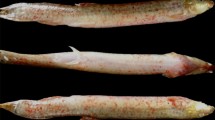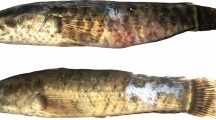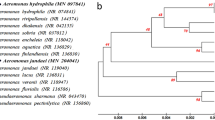Abstract
Outbreaks of mass mortality of postlarval abalone, Haliotis diversicolor supertexta, have occurred in south China since 2002 and have forced many abalone farms to close. About 30 representative bacterial strains were isolated from a sample of five diseased postlarval abalone, taken 25 days post-fertilization during an outbreak of postlarval disease in Shenzhen, China, in October 2006. Bacterial challenge tests showed that the predominant strain, designated as strain 22, was highly virulent to postlarvae with an LD50 value of 7.8 × 104 colony forming units (CFU) ml−1, while four of the other isolates were weakly virulent with LD50 values ranging from 1 × 106 to 1 × 107 CFU ml−1, and the remaining 25 isolates were classified as avirulent with LD50 values greater than 1 × 108 CFU ml−1. By means of API 20NE and 16S rDNA and ITS sequencing analyses, strain 22 was identified as Pseudomonas aeruginosa. Antibiotic susceptibility tests showed that strain 22 exhibited around 75% of susceptibility to 16 various antibiotics tested. The results of this study show P. aeruginosa as one of the bacteria involved in the mortality of abalone postlarvae in Shenzhen, China.


Similar content being viewed by others
References
Angelini NM, Seigneur GN (1988) Disease of the fins of Rhamdia sapo. Isolation of the etiological agents and experimental infection. Rev Argent Microbiol 20:37–48
Anguiano-Beltrán C, Searcy-Bernal R (2007) Effects of antibiotics on the concentration of bacteria in biofilms and on the growth of Haliotis rufescens postlarvae. J Shellfish Res 26(3):795–800. doi:10.2983/0730-8000(2007)26[795:EOAOTC]2.0.CO;2
Cai J, Han Y, Wang Z (2006a) Isolation of Vibrio parahaemolyticus from abalone (Haliotis diversicolor supertexta L.) postlarvae associated with mass mortalities. Aquaculture 257:161–166. doi:10.1016/j.aquaculture.2006.03.007
Cai J, Chen H, Thompson KD, Li C (2006b) Isolation and identification of Shewanella alga and its pathogenic effects on post-larvae of abalone Haliotis diversicolor supertexta. J Fish Dis 29:505–508. doi:10.1111/j.1365-2761.2006.00732.x
Cai J, Han H, Song Z, Li C, Zhou J (2006c) Isolation and characterization of pathogenic Vibrio alginolyticus from diseased postlarval abalone, Haliotis diversicolor supertexta (Lischke). Aquacult Res 37:1222–1226. doi:10.1111/j.1365-2109.2006.01552.x
Cai J, Wang Z, Cai C, Zhou Y (2008) Characterization and identification of virulent Klebsiella oxytoca isolated from abalone (Haliotis diversicolor supertexta) postlarvae with mass mortality in Fujian, China. J Invertebr Pathol 97:70–75. doi:10.1016/j.jip.2007.07.005
Chen JC, Lee WC (1999) Growth of Taiwan abalone Haliotis diversicolor supertexta fed on Gracilaria tenuistipitata and artificial diet in a multiple-tier basket system. J Shellfish Res 18:627–635
Fan H (2001) Study on the gill-rot disease of Anguilla anguilla infected by Pseudomonas. J Fish Sci China 25(2):147–150 in Chinese
Felsenstein J (1985) Confidence limits on phylogenies: an approach using the bootstrap. Evolution 39:783–791. doi:10.2307/2408678
Frederiksen B, Koch C, Hoiby N (1997) Antibiotic treatment of initial colonization with Pseudomonas aeruginosa postpones chronic infection and prevents deterioration of pulmonary function in cystic fibrosis. Pediatr Pulmonol 23:330–335. doi:10.1002/(SICI)1099-0496(199705)23:5<330::AID-PPUL4>3.0.CO;2-O
Freitas AL, Barth AL (2004) Typing of Pseudomonas aeruginosa from hospitalized patients: a comparison of susceptibility and biochemical profiles with genotype. Braz J Med Biol Res 37:77–82
Koneman EW, Allen SD, Dowell JV, Janda WM, Sommers HM, Winn WC (1988) Antimicrobial susceptibility testing. In: Lippincott JB (ed) Color atlas and textbook of diagnostic microbiology. Philadelphia press, PA, USA, pp 231–236
Lyczak JB, Cannon CL, Pier GB (2000) Establishment of Pseudomonas aeruginosa infection: lessons from a versatile opportunist. Microbes Infect 2:1051–1060. doi:10.1016/S1286-4579(00)01259-4
Mathee K, Narasimhan G, Valdes C, Qiu X, Matewish JM, Koehrsen M et al (2008) Dynamics of Pseudomonas aeruginosa genome evolution. Proc Natl Acad Sci USA 105(8):3100–3105. doi:10.1073/pnas.0711982105
Mittal KR, Lalonde G, Leblanc D, Olivier G, Lallier R (1980) Aeromonas hydrophila in rainbow trout: relation between virulence and surface characteristics. Can J Microbiol 26:1501–1503
NCCLS (National Committee for Clinical Laboratory Standards) (1997) Approved Standard M2-A6. Performance standards for antimicrobial disk susceptibility tests, 6th edn. NCCLS, Wayne, Pennsylvania
NCCLS (National Committee for Clinical Laboratory Standards) (1998) Performance standards for antimicrobial susceptibility testing; Eighth Informational Supplement. NCCLS document M100-S8. Wayne, Pennsylvania
Nicolas JL, Basuyaux O, Mazurie J, Thebault A (2002) Vibrio carchariae (syn. Vibrio harveyi), a pathogen of the abalone Haliotis tuberculata. Dis Aquat Organ 50:35–43. doi:10.3354/dao050035
Shiose J, Wakabayashi H, Tominaga M, Egusa S (1974) A report on a disease of cultured carp due to a capsulated Pseudomonas. Fish Pathol 9:79–83
Sneath PHA, Sokal RR (1973) Numerical taxonomy—the principles and practice of numerical classification. Freeman, San Francisco
Stover CK, Pham XQ, Erwin AL, Mizoguchi SD, Warrener P, Hickey MJ et al (2000) Complete genome sequence of Pseudomonas aeruginosa PA01, an opportunistic pathogen. Nature 406:959–964. doi:10.1038/35023079
Thomas B, Michael G (2006) The role of quorum sensing in the pathogenicity of the cunning aggressor Pseudomonas aeruginosa. Anal Bioanal Chem 387:409–414
Thompson DE, Balsdon JT, Cai J, Collins MD (1992) Studies on the ribosomal RNA operons of Listeria monocytogenes. FEMS Microbiol Lett 75:219–234. doi:10.1111/j.1574-6968.1992.tb05420.x
Thompson FL, Iida T, Swings J (2004) Biodiversity of Vibrios. Microbiol Mol Biol Rev 68:403–431. doi:10.1128/MMBR.68.3.403-431.2004
Trevors JV, Lusty CW (1985) A basic microcomputer program for calculating LD50 values. Water Air Soil Pollut 24:431–442. doi:10.1007/BF00282493
Yahr TL, Parsek MR (2006) Pseudomonas aeruginosa. Prokaryotes 6:704–713. doi:10.1007/0-387-30746-X_22
Yang HH, Ting YY (1986) Artificial propagation and culture of abalone (Haliotis diversicolor supertexta, Lischke). Bull Taiwan Fish Res Inst 40:195–201
Acknowledgment
This work was supported in part by a grant, NSFC-40776091, from the Natural Sciences Fund of China.
Author information
Authors and Affiliations
Corresponding author
Rights and permissions
About this article
Cite this article
Cai, J., Lin, S. & Wu, B. Characterization of Pseudomonas aeruginosa associated with diseased postlarval abalone in Shenzhen, China. Aquacult Int 17, 449–458 (2009). https://doi.org/10.1007/s10499-008-9215-5
Received:
Accepted:
Published:
Issue Date:
DOI: https://doi.org/10.1007/s10499-008-9215-5




